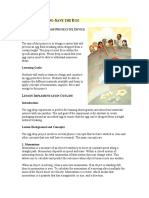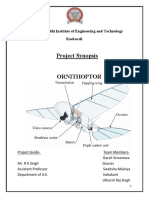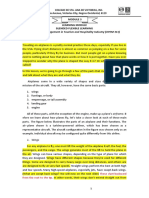General Physics 1
General Physics 1
Uploaded by
Evefel Ruth Yparraguirre SanchezCopyright:
Available Formats
General Physics 1
General Physics 1
Uploaded by
Evefel Ruth Yparraguirre SanchezOriginal Title
Copyright
Available Formats
Share this document
Did you find this document useful?
Is this content inappropriate?
Copyright:
Available Formats
General Physics 1
General Physics 1
Uploaded by
Evefel Ruth Yparraguirre SanchezCopyright:
Available Formats
I.
Title: Spongy Roll Egg Drop
II. Objectives: In conducting the performance task the students must obtain the
following objectives;
Design a sturdy, impact-resistant outer structure for a lander, utilizing
foam soft padding or shock-absorbing mechanisms to absorb forces
during free fall, minimizing egg impact.
The lander should balance its weight to reduce impact force on the egg
during landing, while also providing sufficient cushioning and protective
space.
Explore shock-absorbing mechanisms like springs, rubber bands, or air-
filled compartments to distribute impact forces throughout the lander,
minimizing shock transmission to the egg.
Develop stableization techniques for controlled descent to prevent egg
breaking during fall, incorporating weight distribution of fins and other
aerodynamic features.
The design of the lander will be tested and refined through iterative
experimentation, analyzing the egg's impact forces and identifying areas
for improvement.
III. Materials/Budget List:
IV.
Sponge
Toilet paper roll
Electrical Tape
Scotch tape
Umbrella panel
Egg
Yarn/ string
Husk of coconut
Budget: 50 pesos
V. Documentation (Before egg landing)
VI. Observation
Kinematic and free fall - The way an egg lander lands depends on its speed the
angle at which it is thrown the resistance it encounters from the air and the
condition of the surface it lands on. If the egg is thrown horizontally or at an
angle it follows a path called a parabola. When falling freely it accelerates
downward due, to gravity. The condition of the landing surface and how well the
egg can absorb impact also play a role in determining its path. Air resistance
plays a role for objects that are not aerodynamic, such as eggs. In the absence of
factors like a parachute an egg may slow down as it falls. Techniques, like using
cushioned surfaces or deploying parachutes can increase the likelihood of a
landing.
Acceleration final & initial -When the person holding the egg lander release the
egg lander, the force of gravity pulls it downward, and the egg lander speeds
toward the ground. The faster the egg lander falls, though, the more drag it
creates. The drag force resists the downward movement of gravity, pushing the
egg lander back up. Within the 11-13 seconds time frame the egg lander lands to
the ground.
Displacement/ initial distance & final - The egg lander is falling, speeding up with
each second as it does so. Air resistance rises in tandem with the increase in
speed. The force of gravity is balanced by the force of air resistance. The
quantity of air resistance rises steadily as the egg lander descends, eventually
reaching a level that is comparable to the gravitational pull of gravity. The egg
lander stops accelerating once there is a balance of forces and the force of air
resistance equals the force of gravity. So based on the performance, the egg
lander has reached its final rate. Thus, the lander touched down on the ground
after 13 seconds.
VII. Documentation (after landing)
VIII. KEY QUESTIONS
-What are some features you think would help to land your spacecraft safely?
The name of our egg lander is spongey roll egg drop. Where it is inspired from
the movie up where the house are full of balloons, however, instead of balloons,
we are using old and broken umbrella for parachute to help our spacecraft land
safety. Our egg is in the center between the role cover of notebook, inside the
roll notebook is coconut husk to support and a small part of egg tray to hold the
egg. Sponge is for our base and top to use for safe landing and lastly tape for
extra protection for egg will not fall to our egg lander. So far this is our unique
features to help our spacecraft to land safely.
-What are the advantages and disadvantages of these elements?
The first advantage of our spacecraft is our lightweight beacuse using
lightweight materials like sponges and our parachute can help reduce the overall
mass of the egg lander, making it easier to achieve a slow descent and softer
landing. Also sponge can absorb and distribute the impact forces during landing,
reducing the risk of cracking or breaking the egg. And lastly our materials are all
recylable and available at home therefore, the materials of our spacecraft is not
expensive. However there are also disadvatages in creating our spacecraft
design. For instance, the sponge our using is too light that may not be
structurally strong enough to withstand the impact forces during landing and it
will bounced in the ground.
-Why did you choose particular elements of your spacecraft design?
The basis of creating our spacecraft is typically revolves around the objective of
protecting an egg during a simulated landing. As we plan, the primary goal of our
spacecraft is to protect the egg from impact or collision forces and our design
should focus on providing cushioning and shock-absorbing properties to ensure
that the egg remains intact during landing. Then, we consider also the overall
weight of the spacecraft because the lighter the structure, the slower the
descent, and the gentler the impact. Balancing structural integrity with weight
reduction is crucial for successful landings. Also we consider the resources
available, including materials, tools, and budget, may influence the design
decisions. And lastly, we choose this particular elements because of the quality
of our spacecraft design.
-What are some of the disadvantages of the elements you chose? What were the
advantages?
There are some factors of the elements that we used in crafting our egg lander.
There is a percentage that the elements used is not sustainable enough to
support the egg like in the sponge, the sponge that were use is not that large
enough of is thin which can break the egg when if hits the surface. However, the
sponge somehow did help support our egg lander because it still did protect the
egg from breaking when it hit the surface.
-If you were to redesign your lander, what would you change and why?
If we were to redesign or reconstruct our lander, we will probably ve revising
our parachute. Since parachute has a great contribution in resisting the air.
Unfortunately, our parachute is not that strong enough to hold and support the
heavy materials that is supporting or protecting the egg from breaking. That is
why, if given a chance, revising our parachute will be one of our priorities in
securing our lander. But still, even though the parachute did not support that
much, the egg landing was still successful since it didn't break the egg.
You might also like
- Glider Paper #1Document5 pagesGlider Paper #1Dawn100% (1)
- Effectiveness of Distribution Channel Questionnaire ShodhgangaDocument13 pagesEffectiveness of Distribution Channel Questionnaire Shodhgangaalkanm75083% (6)
- November 07, 2016 PDFDocument8 pagesNovember 07, 2016 PDFChristine HogueNo ratings yet
- Making Wooden Glider in RMIT ReportDocument25 pagesMaking Wooden Glider in RMIT ReportHao SuNo ratings yet
- Computer Fundamentals Question Bank Unit-1: Fundamentals of ComputersDocument4 pagesComputer Fundamentals Question Bank Unit-1: Fundamentals of ComputersMr. MANTRA100% (1)
- Egg Drop LabDocument6 pagesEgg Drop LabCarmen DraghiaNo ratings yet
- Egg Drop Lab ReportDocument6 pagesEgg Drop Lab ReportMaimouna JallowNo ratings yet
- Tensegrity Based Morphing Structures: Project ReportDocument15 pagesTensegrity Based Morphing Structures: Project ReportKenechukwu OkoyeNo ratings yet
- Supercool Paper Airplanes Ebook: 12 Paper Airplanes; Assembled in Under a Minute: Includes Instruction Book with Downloadable Plane TemplatesFrom EverandSupercool Paper Airplanes Ebook: 12 Paper Airplanes; Assembled in Under a Minute: Includes Instruction Book with Downloadable Plane TemplatesRating: 4.5 out of 5 stars4.5/5 (3)
- Egg Drop Lesson: Essential QuestionsDocument4 pagesEgg Drop Lesson: Essential QuestionsNiles sethsNo ratings yet
- ParachuteDocument2 pagesParachuteMohd AmirNo ratings yet
- I. Background of The StudyDocument5 pagesI. Background of The StudyMay John Jenon BaroyNo ratings yet
- Grade 6 FlightDocument14 pagesGrade 6 FlightHarish MathiazhahanNo ratings yet
- Paper Airplane PhysicsDocument16 pagesPaper Airplane Physicsapi-296709346100% (1)
- Grade 6 Air AerodynamicsDocument14 pagesGrade 6 Air AerodynamicsHarish MathiazhahanNo ratings yet
- AFS Paper Airplanes: Incredible Designs You Can Make at HomeFrom EverandAFS Paper Airplanes: Incredible Designs You Can Make at HomeRating: 5 out of 5 stars5/5 (1)
- Forces of FlightDocument50 pagesForces of FlightSakthi MuruganNo ratings yet
- Egg Drop 2015 Lab Activity InstructionsDocument11 pagesEgg Drop 2015 Lab Activity Instructionsmuhammad adliNo ratings yet
- Delta WingDocument3 pagesDelta WingAditya RaghuwanshiNo ratings yet
- Aviation For KidsDocument81 pagesAviation For KidsJuan Carlos PASQUEL G.No ratings yet
- Notes on the Tailwheel Checkout and an Introduction to Ski FlyingFrom EverandNotes on the Tailwheel Checkout and an Introduction to Ski FlyingNo ratings yet
- Paper Airplanes Experiment GuideDocument2 pagesPaper Airplanes Experiment Guidejackietran06No ratings yet
- Project Related To Inflatable WingDocument49 pagesProject Related To Inflatable WingBandaru SwethaNo ratings yet
- Project SynopsisDocument15 pagesProject SynopsisGARVIT SRIVASTAVANo ratings yet
- Collapses and TurbulenceDocument3 pagesCollapses and TurbulencedanielvillavicenciogNo ratings yet
- Egg Drop ExperimentDocument4 pagesEgg Drop ExperimentalyannaxysabelleNo ratings yet
- Instant Paper Airplanes Ebook: 12 Printable Airplanes You Tape Together and Fly!From EverandInstant Paper Airplanes Ebook: 12 Printable Airplanes You Tape Together and Fly!No ratings yet
- Principles of Flight For The Private Pilot (Aviation Books For The Private Pilot)Document79 pagesPrinciples of Flight For The Private Pilot (Aviation Books For The Private Pilot)zackNo ratings yet
- SSG PDFDocument4 pagesSSG PDFsrirubanNo ratings yet
- Space Shuttle Paper AirplaneDocument4 pagesSpace Shuttle Paper AirplaneJosé Nunes FilhoNo ratings yet
- Flight Powerpoint MS. NORWRYDocument56 pagesFlight Powerpoint MS. NORWRYWiktor MikołajczakNo ratings yet
- Space Shuttle GliderDocument4 pagesSpace Shuttle GliderAviation/Space History LibraryNo ratings yet
- Aerodynamics of An Aiplane Wings: Seminar ONDocument20 pagesAerodynamics of An Aiplane Wings: Seminar ONSwapnil JadhavNo ratings yet
- Parts of An AirplaneDocument12 pagesParts of An AirplaneMaritoni MedallaNo ratings yet
- Wing Design K-12Document56 pagesWing Design K-12aeroacademic100% (1)
- How To Reduce Friction: Science ProjectDocument4 pagesHow To Reduce Friction: Science ProjectP.TAVAMANI A/P PERUMAL MoeNo ratings yet
- Flight: by Joelle WightDocument23 pagesFlight: by Joelle Wightapi-281994074No ratings yet
- Jet Engine: How Does A Parachute Work in Theory?Document3 pagesJet Engine: How Does A Parachute Work in Theory?Sidny BatulanNo ratings yet
- Literature ReviewDocument7 pagesLiterature Reviewapi-609520648No ratings yet
- Design and Development of An OrnithopterDocument20 pagesDesign and Development of An OrnithopterWhite KnightNo ratings yet
- Research For Paper AirplanesDocument4 pagesResearch For Paper Airplanesh03xhmf3100% (1)
- Water Rocket ReportDocument19 pagesWater Rocket ReportThe AlphabetsNo ratings yet
- PresentationpowerpointDocument6 pagesPresentationpowerpointapi-327120188No ratings yet
- PresentationpowerpointDocument6 pagesPresentationpowerpointapi-327119964No ratings yet
- ACP 33 Volume 4 AirframesDocument104 pagesACP 33 Volume 4 AirframesBen NimmoNo ratings yet
- Forensic Engineering 2020Document23 pagesForensic Engineering 2020Santiago MonroyNo ratings yet
- Aerodynamics HomeworkDocument7 pagesAerodynamics Homeworkafmsxeghf100% (1)
- Gliders Vs Jets Intro Essay Exper Graph Discu Concl and BibDocument13 pagesGliders Vs Jets Intro Essay Exper Graph Discu Concl and Bibapi-264572871No ratings yet
- ScienceprojectlabreportDocument5 pagesScienceprojectlabreportapi-321988186No ratings yet
- Ditching-How To FDocument14 pagesDitching-How To FpukitetekNo ratings yet
- Midterm Module 2Document9 pagesMidterm Module 2Cielito CaguiaNo ratings yet
- Egg Dropping Expirement: Donna Mae LaurenteDocument18 pagesEgg Dropping Expirement: Donna Mae LaurenteIan Mar Leos PresenteNo ratings yet
- 1 Nelson - Take Flight! - AnswersDocument2 pages1 Nelson - Take Flight! - Answersdmccloy28No ratings yet
- Forensic Engineering: Global Phases of The Life-Cycle of Technical SystemsDocument22 pagesForensic Engineering: Global Phases of The Life-Cycle of Technical SystemsSantyy 'z WaYNo ratings yet
- Hot Air Balloon Sciences-4th-Quarter-ScaffoldDocument4 pagesHot Air Balloon Sciences-4th-Quarter-ScaffoldAngel Trisha Mae AlmeydaNo ratings yet
- Flapping Wings - OrnithopterDocument9 pagesFlapping Wings - Ornithopterleelavathy100% (1)
- Student Log BookDocument13 pagesStudent Log Bookapi-237655094No ratings yet
- Profielwerkstuk Lift ForceDocument20 pagesProfielwerkstuk Lift ForceStan De SchepperNo ratings yet
- 02a. Structure (A)Document34 pages02a. Structure (A)5gk9scnnx9No ratings yet
- SA Activities Make Your Own AircraftDocument16 pagesSA Activities Make Your Own Aircraftscottmora1511No ratings yet
- Acp033 Vol4Document104 pagesAcp033 Vol4Marcus Drago100% (1)
- !STQ - Diagnostic Test in Science 10Document4 pages!STQ - Diagnostic Test in Science 10Evefel Ruth Yparraguirre SanchezNo ratings yet
- G10 Science Q1-W4-5 - Tectonic BoundariesDocument39 pagesG10 Science Q1-W4-5 - Tectonic BoundariesEvefel Ruth Yparraguirre SanchezNo ratings yet
- Diagnostic Test in Science 10Document3 pagesDiagnostic Test in Science 10Evefel Ruth Yparraguirre SanchezNo ratings yet
- Ucsp Q1 Week2Document4 pagesUcsp Q1 Week2Evefel Ruth Yparraguirre SanchezNo ratings yet
- 4thQFIRST WRITTEN SUMMATIVE TEST IN BIOTECHNOLOGYDocument1 page4thQFIRST WRITTEN SUMMATIVE TEST IN BIOTECHNOLOGYEvefel Ruth Yparraguirre SanchezNo ratings yet
- MeoowDocument33 pagesMeoowEvefel Ruth Yparraguirre SanchezNo ratings yet
- 2ndqbiotechweek5 7Document3 pages2ndqbiotechweek5 7Evefel Ruth Yparraguirre SanchezNo ratings yet
- 2ndqbiotechsummative wk1-4Document2 pages2ndqbiotechsummative wk1-4Evefel Ruth Yparraguirre SanchezNo ratings yet
- Hickman 2015 The Impact of Fan Identification, Purchase Intentions, and Sponsorship Awareness On Sponsors' Share of WalletDocument1 pageHickman 2015 The Impact of Fan Identification, Purchase Intentions, and Sponsorship Awareness On Sponsors' Share of Walletnugraha.muhammadiqbal24No ratings yet
- Paper: 08, International Business Operations: ManagementDocument12 pagesPaper: 08, International Business Operations: ManagementMonika SainiNo ratings yet
- CFMTTI DudhniDocument35 pagesCFMTTI DudhniVISHAL SINGHNo ratings yet
- Proposal StrutDocument3 pagesProposal StrutSanson OrozcoNo ratings yet
- DMTDocument1 pageDMTPipo Canelas100% (3)
- Eapp ReportDocument26 pagesEapp ReportRuth OlavereNo ratings yet
- PPTDocument18 pagesPPTAdrian PerezNo ratings yet
- Unlock Galaxy Phones XDA (Owl7MINsizeDocument6 pagesUnlock Galaxy Phones XDA (Owl7MINsizeshaoran_leeNo ratings yet
- Electronic Contribution Collection List SummaryDocument3 pagesElectronic Contribution Collection List SummaryMICAH ELLANo ratings yet
- Literature ReviewDocument4 pagesLiterature Reviewapi-549248807No ratings yet
- 21 Writing TipsDocument8 pages21 Writing TipsCyrilleNo ratings yet
- 2nd PU Political Science Model QP 3Document7 pages2nd PU Political Science Model QP 3Prasad C M67% (9)
- Presentation On Genera Banking Activities of SEBLDocument15 pagesPresentation On Genera Banking Activities of SEBLKhan Mohammad ShahadatNo ratings yet
- Science - 4 Quarter 1 WEEK 1 7 Final 3Document49 pagesScience - 4 Quarter 1 WEEK 1 7 Final 3TakhNo ratings yet
- Templates Package 1 ContentDocument1 pageTemplates Package 1 Contentسيلفا سيلفاNo ratings yet
- Hibernate XDoclet Tutorial-1.4Document36 pagesHibernate XDoclet Tutorial-1.4kajini2No ratings yet
- Cracked NipplesDocument2 pagesCracked NipplescibunNo ratings yet
- Strategic Management in Business CheatsheetDocument2 pagesStrategic Management in Business CheatsheetBobo WongNo ratings yet
- Selling Brand QDocument15 pagesSelling Brand QVani SaraswathiNo ratings yet
- (Lift) EMSD 12 - 97Document6 pages(Lift) EMSD 12 - 97CescyCowCowNo ratings yet
- The Development of Concrete Technology in MalaysiaDocument2 pagesThe Development of Concrete Technology in MalaysiaToyo KoyanagiNo ratings yet
- Kawasaki Brute Force Owner's ManualDocument20 pagesKawasaki Brute Force Owner's ManualmitkoplaygamezNo ratings yet
- Chapter 2 Elasticity of Demand On TransportationDocument12 pagesChapter 2 Elasticity of Demand On Transportationsamirmina.6290No ratings yet
- (Tutorial) HTML5 GamesDocument44 pages(Tutorial) HTML5 GamesanonymousNo ratings yet
- Arbitration 90 Hidden Secret of Indian Index and How To Use 4Document70 pagesArbitration 90 Hidden Secret of Indian Index and How To Use 4Ravi SinghNo ratings yet
- Report PPM Sakai Triputra Group by An (130623) ..Document6 pagesReport PPM Sakai Triputra Group by An (130623) ..mauNo ratings yet
- SKM 100 GB 128 DDocument6 pagesSKM 100 GB 128 DВиктор ПоздняковNo ratings yet

































































































